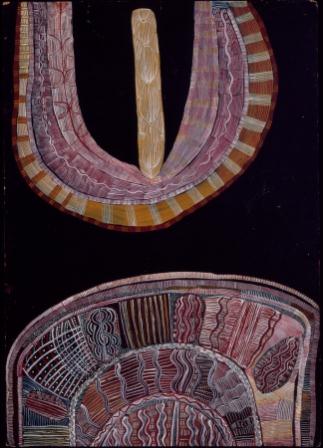
Mick Namarari Tjapaltjarri (c. 1926-1998) Pintupi. Big Cave Dreaming with Ceremonial Object, 1972 © The Artist – Photo Courtesy Embassy of Australia, United States
“Beauty has many forms, but it is not every day that a new kind of beauty is born to the world.” – Curator, Roger Benjamin[1]
Icons of the desert is a touring exhibition of early Australian Aboriginal paintings from the Western desert outpost of Papunya. It was first exhibited in 2009 at the Johnson Museum (January 10 – April 5, 2009).
It was in Papunya in the early 1970s that the birth of the Western Desert painting movement is attributed. This was facilitated by young schoolteacher Geoffrey Bardon who encouraged a local group of Aboriginal men to transfer their iconic imagery onto board, providing them with the paints to do so. This process represented a permanent affirmation of Aboriginal cultural identity and a significant moment in the development of the Aboriginal art industry.
Icons of the desert is the first exhibition to focus on this founding period. Curated by Professor Roger Benjamin of the University of Sydney, the exhibition consists of significant works by artists including Clifford Possum Tjapaltjarri, Tim Leura Tjapaltjarri, and Uta Uta Tjangala amongst other major names. The exhibition is formed from the private collection of John and Barbara Wilkerson and took over a decade to develop in close consultation with the Aboriginal community.
This exhibition is unique, not only because of the powerful visual quality of the Papunya works and their skilful transmission of cultural meaning – but also because only 750 works were ever produced, making it a rare opportunity to encounter this story in the flesh.
Icons of the desert is on exhibition at the Embassy of Australia gallery in Washington from 18 October to 31 January 2014.
A fully illustrated, hardcover publication of the exhibition is available from the Icons of the Desert website.
The exhibition is also supported by a number of public events including a screening of the film Mr Patterns – the story of Geoff Bardon, followed by a Director’s talk by Catriona McKenzie on 5 November and a major panel discussion on the cultural heritage act to be held at the Embassy on 3 December, 2013.
SOURCES:
Embassy of Australia, United States of America http://www.usa.embassy.gov.au/whwh/events.html
Icons of the Desert: Early Aboriginal Paintings from Papunya http://www.iconsofthedesert.com/about.html
References:
[1] Embassy of Australia website, as quoted from the hardcover publication designed for the exhibition “icons of the desert”, essay by Professor Roger Benjamin, Director, The Power Institute, and University of Sydney